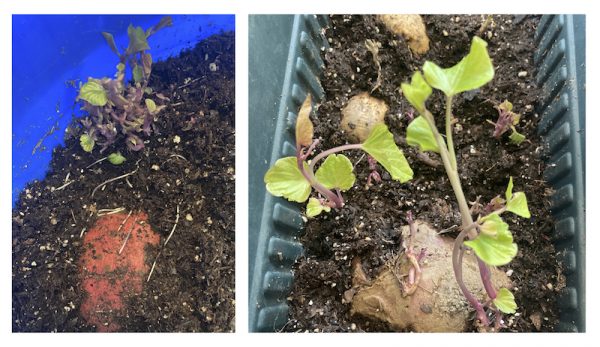
During the winter heating season, the closet right next to my furnace is particularly toasty. Mostly that’s because the ductwork in my old house leaves a lot to be desired. Nevertheless, I’ve been able to put that extra-warm spot to good use.
Turns out, it’s perfect for growing sweet potato slips. (Slips are baby plants which grow off of sweet potato tubers, and warmth really spurs their development.)
Now, if you grew your own sweet potatoes last season and still have some decent tubers left, you might want to try starting some slips for yourself. (Alternatively, you might also have success with store-bought, organic sweet potatoes that haven’t been treated with a growth inhibitor.)
Just one sweet potato can net you at least 20 slips—and often many more than that.
Read more: Here are some pointers for growing and curing your own sweet potatoes.
Supplies for Sweet Potato Slips
You should pick only the healthiest-looking sweet potatoes to propagate. That means rejecting sweet potatoes with blemishes, cuts and obvious signs of disease.
Sickly potatoes can result in sickly slips. If the slips you grow are compromised, your new sweet potato crop likely will be, too.
You should also choose sweet potatoes that are your preferred size and shape, since the slips typically take after the “mother” tuber from which they grew. Aside from your mother sweet potatoes, you’ll also need growing containers, soil and a seedling heat mat.
When growing slips, cleanliness is paramount. To help guard against disease, I soak my pots in a mild bleach solution, rinse well, then follow up with a scrub in hot, soapy water and a final rinse. I also use sterile potting mix, rather than garden soil which, itself, can harbor disease, fungal gnat larvae and other potential troublemakers.
When to Start?
How do you know when to start your slips? Sweet potatoes thrive in hot soil. So, in part, when you start your slips will depend on the number of hot days that the varieties you’re growing ultimately require to mature. Some “early” sweet potato types can develop respectable tubers much sooner than their late-season counterparts.
Let’s say you live in the Deep South with its long, hot summers. You could easily grow long-season sweet potatoes like Sandhill Preservation Center‘s Jersey Orange and Stoker Red. And you can plant your slips out in the garden much sooner than I can, since my Indiana growing season has comparatively fewer hot days.
As a result, I grow early heirlooms such as Ivis White Cream and Ginseng Red. And I don’t put them out in my garden until my soil is consistently warm. (To be safe, I wait a couple of weeks after my average last frost date and I also use plastic sheeting to help warm up my planting areas ahead of time.)
Incidentally, if you have enough space indoors, you can always start new sets of slips every couple of weeks and then successively plant them out in the garden. Keep notes about the performance of each of these waves of slips. Then you’ll be able to use this information as you decide when to start your slips next year.
Read more: Get a jump on spring with an indoor gardening setup.
Get Growing
When you are ready to plant, fill your containers a little less than halfway with potting mix. Next, lay your potatoes horizontally on top of the soil, pressing them down slightly so that they make good contact. Finally, surround them with just enough additional soil mix that about half of each sweet potato is still plainly visible above the soil line.
Water them in, and keep the soil relatively moist.
Ideally, the soil temperature should be about 70 to 75 degrees F. That means, if you don’t have a really warm spot already, you’re going to want to use a seedling heat mat. And, unless you have a very sunny room, you might also need to use supplemental garden lighting.
Complete with leaves and bright, white roots, little clumps of slips will appear on the outside of your semi-planted tubers. When my slips are about 4 or 5 inches tall, I gently pull them off of their mother potato and separate them from one another.
If I’ve timed things right, I can plant them out in the garden right away. But if I haven’t? I’ll transplant individual slips into newspaper or peat pots, and keep them warm and watered until I can plant them outside.
When it is time to get them in the ground, I carefully tear open the bottom of each pot, so that plant roots can more easily penetrate the soil—and generate a bumper crop of sweet potatoes along the way.




